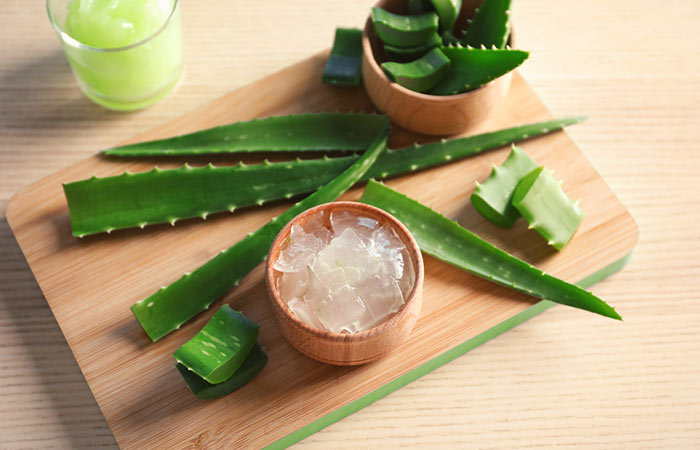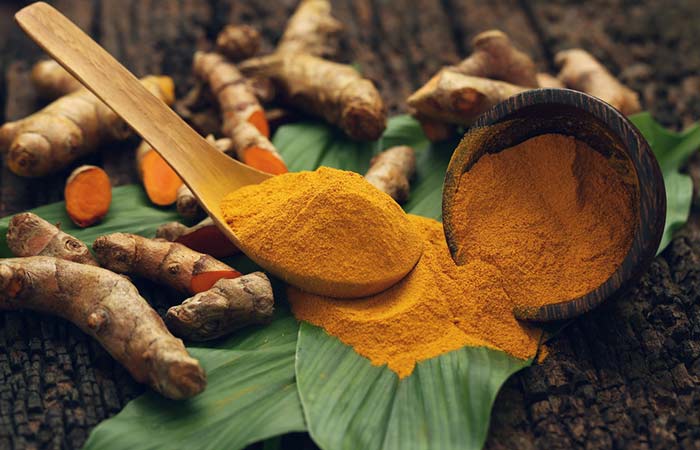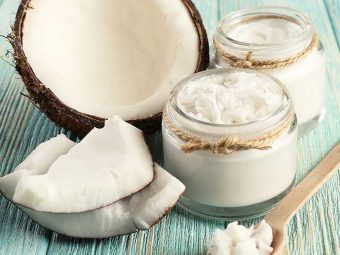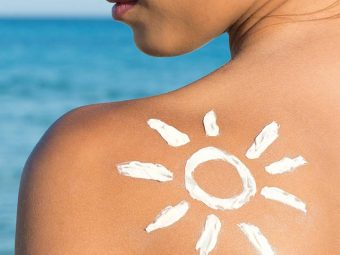How To Remove Tan From The Hands
Easy DIY remedies to fade unwanted tanning and restore your original skin tone.

Image: ShutterStock
Sunbathing and vacationing go hand in hand. Because our hands are exposed most extensively to the sun’s rays, they take the most damage. Prolonged sun exposure, especially if you have forgotten the sunscreen, results in blotchy and tanned skin on the hands and can make you self-conscious in social situations. Luckily, you can remove tan from your hands by following simple home remedies.
Continue reading and learn more about how to remove sun tan from your hands.
In This Article
Why Do We Get Tanned?
Tan is the pigmentation in your skin when it is exposed to excessive sunlight. Melanin is the pigment that gives your skin its color. On exposure to sunlight, your skin overproduces melanin, thereby imparting a tanned look. This also often makes your skin look dull.
Contrary to popular belief, melanin production in your skin is not mere pigmentation but your body’s mechanism to protect you from harmful UV rays of the sun. This makes it imperative to protect your hands and prevent unwanted tanning. We have discussed prevention tips later in this article.
Let’s first look at a few home remedies that can help fade the tan on your hands.
Home Remedies To Fade Tan From Your Hands
1. Yogurt
Yogurt contains L-cysteine peptide, a compound that is known to suppress tyrosinase activity (1). This helps reverse the effects of excessive pigmentation, which may fade a tan and effectively exfoliate your hands.
You Will Need
- 2-3 tablespoons of yogurt
- 1 tablespoon of lemon juice
What You Have To Do
- Mix a few tablespoons of yogurt with lemon juice.
- Apply this paste on your hands and leave it on for 15 minutes.
- Wash it off with plain water.
How Often You Should This
You can apply this paste on your hands one to two times every week.
Caution: Do not forget to carry out a patch test before you use this remedy as lemon juice can cause skin irritation.
Chitralekha Paul, a YouTuber, shares her journey of getting rid of tan. She said applying yogurt worked for her. She further adds, “I applied plain yogurt on my face and my body two or three times a week, I did that [and] it did help me achieve a bright skin soft and bright skin (i).”
 Quick Tip
Quick Tip2. Tomato
Tomatoes are rich in bioactive compounds called carotenoids that function as photo protectants (2). They can reduce the tan caused by harmful UV rays of the sun.
You Will Need
2 medium-sized tomatoes
What You Have To Do
- Blend the tomatoes to make a thick paste.
- Apply this paste on your hands.
- Leave on for 15 minutes and wash it off with water.
How Often You Should This
You can do this two times a week.
3. Lemon Juice
Vitamin C or ascorbic acid is the major constituent of lemon juice. It is known to have anti-pigmentary properties that can help in reducing the effects of skin tan (3).
You Will Need
- A lemon
- Water
- Cotton ball
What You Have To Do
- Extract the juice of a lemon. Dilute it with water.
- Soak a cotton ball in it and apply it to the hands.
- After 15-20 minutes, rinse it off with water.
How Often You Should This
Repeat this two times a week.
Caution: Lemon juice can cause a stinging sensation on your skin. Please do a patch test before trying this remedy. It also increases the sensitivity of your skin to UV light. Hence, make sure you use diluted lemon juice and wash it off thoroughly after the specified duration.
4. Aloe Vera
Aloe vera contains bioactive compounds (aloesin, aloe emodin, and aloin) that suppress tyrosinase activity (4). This translates to reduced pigmentation on your skin.
You Will Need
- 2-3 teaspoons of aloe vera gel
- 1 teaspoon honey
What You Have To Do
- Extract the gel from the aloe vera leaf and mix it with honey.
- Apply this pack on your hands and leave it on for 10 minutes.
- Wash it off with plain water.
How Often You Should This
For best results, apply this paste on your hands two to three times every week.
5. Cucumber
Cucumber not only has moisturizing properties but also contains bioactive compounds (like trans, cis-2,6-nonadienal) that inhibit tyrosinase activity and reverse the effects of sun tan (5).
You Will Need
- A cucumber
- 1 tablespoon aloe vera gel
What You Have To Do
- Slice half a cucumber and blend it in a blender.
- Add a tablespoon of aloe vera gel to this and mix well.
- Apply this mixture on your hands and rinse off.
How Often You Should This
Apply this once a week until the tan disappears.
6. Papaya
Papaya extracts act as exfoliants and can help slough away dead skin cells from the surface of your skin (6). This helps in fading the tan on your hands.
You Will Need
- 1 ripe papaya
- 1 lemon
What You Have To Do
- Blend the papaya into a puree and add a teaspoon of lemon juice to it.
- Mix well and apply it to your hands.
- Rinse off with water after 15-20 minutes.
How Often You Should This
Repeat two times a week.
Caution: Do a patch test before you use this remedy as lemon juice can cause skin irritation.
7. Honey
Honey has excellent moisturizing properties and promotes tissue repair. It not only softens your skin and makes it smooth but also contains antioxidants that reverse the skin damage caused by UV rays (7), (8).
You Will Need
- 1 tablespoon honey
- 1 lemon
What You Have To Do.
- Extract the juice from a lemon and add honey to it.
- Apply this mixture to your hands.
- Wash it off with water after 10-15 minutes.
How Often You Should This
Apply this paste two times a week.
Caution: Carry out a patch test before you use this remedy as lemon juice can irritate your skin.
8. Orange Peel
Studies show that the peel of an orange contains compounds that can suppress melanogenesis and reverse the effects of sun tan (9). The juice in oranges moisturizes your skin.
You Will Need
- 1 teaspoon of powdered orange peel
- 1 pinch of turmeric powder
- 1 teaspoon of honey
What You Have To Do
- Mix the ingredients to make a fine paste.
- Apply on your hands and leave it on for 15 minutes.
- Rinse off with water.
How Often You Should This
You can do this two times a week.
9. Turmeric
Turmeric contains curcumin that inhibits melanogenesis (10). This leads to reduced production of melanin, thereby fading the tan on your hands.
You Will Need
- 1 teaspoon turmeric powder
- 1 teaspoon of milk
What You Have To Do
- Prepare a pack using the ingredients above and apply it to your hands.
- Leave it on until it dries.
- Wash your hands thoroughly with water
How Often You Should This
Do this once every week until the tan disappears.
10. Saffron
Saffron is widely used in traditional medicine to restore the natural complexion. Research shows that it has a moisturizing effect on your skin and also eliminates the damage to your skin caused by UV rays of the sun (11).
You Will Need
- ¼ cup of fresh milk
- A few strands of saffron
What You Have To Do
- Soak the saffron strands in milk for 2 hours.
- Strain the milk and apply it to the tanned areas.
- Wash it off with plain water after 10-15 minutes.
How Often You Should This
Do this 1-2 times a week.
 Quick Tip
Quick TipThis was a list of simple home remedies that can help lighten the tan on your hands. Now, let’s see how you can prevent getting tanned.
A survey conducted on 12,397 participants in 2019 found that an estimated 3% of Canadians aged 12 or older used indoor UV tanning in the last year. It was further noted that the prevalence of using indoor tanning was 42.4% for women between 18 – 34 and 21.6% for women between 35 – 44.
Tips To Prevent Your Hands From Tanning
- Use sun-protective clothing.
- Use sunscreen lotion before stepping out into the sun.
- Do not forget to reapply sunscreen upon prolonged exposure to sunlight.
- Always wash your hands and apply hand cream before you sleep.
Infographic: 5 Most Accessible Home Remedies For Tanned Hands
Hands are often overlooked when it comes to skincare, but they deserve equal TLC. It is understandable, though, if you don’t want to spend hours taking care of your hands. If that’s the case with you, check out this infographic, as it has the easiest and most accessible ways on how to remove tan from your hands immediately and make your arms look radiant and well cared for. Illustration: StyleCraze Design Team
Exposure to the sun for extended periods without sunscreen can lead to tanned hands. Tanning is the body’s mechanism of protecting the skin from harmful UV rays. You can try simple natural remedies at home to remove the tan from your hands. Using organic ingredients such as yogurt, orange peel, tomatoes, lemon, honey, or aloe vera twice a week may help lighten the tan on your hands. Taking precautionary measures such as applying sunscreen and wearing sun-protective clothing can prevent tanning in the first place.
Frequently Asked Questions
Is a tan permanent?
Tanning by exposure to sunlight need not be permanent. However, if you regularly get tanned by artificial methods, you could be subjecting your skin to permanent damage.
Does bleach remove tan?
Bleach can remove tan, but not to a large extent. However, regular use of bleach can cause severe damage to your skin.
How long does sunburn take to heal?
Mild sunburn can take up to 2-3 days to heal. If you have a more severe burn, it can take more than 10 days to heal.
Can coffee remove tan?
Yes, coffee is a fantastic exfoliant that aids in tan removal. You can apply a mixture of coffee powder with raw milk or honey to your face. Leave it on for 15 minutes and wash off with cold water.
How long does a tan take to fade?
While a tan may start fading in 7 to 10 days, it can take up to 30 days to disappear entirely. However, this duration depends on the individual’s skin tone and type.
Does coconut oil remove tan?
Although coconut oil can help your skin in many ways, tanning is not one of them. While it provides some protection from the sun’s harmful UV rays, it does not shield you against sunburn or tanning.
Does a scrub remove tan?
Yes. Gently exfoliating your skin with a scrub can help lighten its tone by removing the dead skin cells from the surface.
Does masoor dal remove tan?
Yes, masoor dal may be able to remove tan. Anecdotal evidence claims that masoor dal or Indian red lentils may have anti-tanning properties that may help tackle sun tan, dark spots, and blemishes. However, there is a lack of scientific evidence supporting this claim. Nonetheless, it is considered to be an effective natural exfoliant that may help in achieving clearer skin. You can try soaking masoor dal overnight and then grind it into a paste. Use the paste as an exfoliator and follow up with a gentle moisturizer.
Key Takeaways
- Natural bleaching agents like lemon juice can lighten tanned skin.
- To lessen the appearance of a tan, apply a yogurt and turmeric mixture to your hands.
- Tanned hands can be hydrated and soothed by applying aloe vera gel to the skin.
- You can also apply a hand pack made of a honey and milk mixture or cucumber juice.
- To get rid of dead skin cells and brighten the skin, use an exfoliating scrub of oatmeal and tomato juice.
Say goodbye to sun tanning with these natural home remedies! Check out the video to learn how to remove tan in just 10 days without using any chemicals.
Personal Experience: Source
StyleCraze's articles are interwoven with authentic personal narratives that provide depth and resonance to our content. Below are the sources of the personal accounts referenced in this article.
i. How I Removed Years Old Tan from my Skin| Tan removal home remedies| sunscreen for face, skinhttps://www.youtube.com/watch?v=1xq6T5PZXS0
References
Articles on StyleCraze are backed by verified information from peer-reviewed and academic research papers, reputed organizations, research institutions, and medical associations to ensure accuracy and relevance. Read our editorial policy to learn more.
- Systemic skin whitening/lightening agents: What is the evidence? Indian Journal of Dermatology, Venerology and Leprology.
https://www.ijdvl.com/article.asp?issn=0378-6323;year=2013;volume=79;issue=6;spage=842;epage=846;aulast=Malathi - Tomatoes protect against development of UV-induced keratinocyte carcinoma via metabolomic alterations, Scientific Reports, US National Library of Medicine, National Institutes of Health.
https://www.ncbi.nlm.nih.gov/pmc/articles/PMC5506060/ - Topical Vitamin C and the Skin: Mechanisms of Action and Clinical Applications, The Journal of Clinical and Aesthetic Dermatology, US National Library of Medicine, National Institutes of Health.
https://www.ncbi.nlm.nih.gov/pmc/articles/PMC5605218/ - Tyrosinase inhibitory components from Aloe vera and their antiviral activity, Journal of Enzyme Inhibition and Medicinal Chemistry, US National Library of Medicine, National Institutes of Health.
https://www.ncbi.nlm.nih.gov/pmc/articles/PMC6010052/ - Exploring cucumber extract for skin rejuvenation, African Journal of Biotechnology, Academic Journals.
https://academicjournals.org/article/article1380726732_Akhtar%2520et%2520al.pdf - Traditional and Medicinal Uses of Carica papaya, Journal of Medicinal Plants Studies.
https://www.plantsjournal.com/vol1Issue1/Issue_jan_2013/2.pdf - Honey: A Therapeutic Agent for Disorders of the Skin, Central Asian Journal of Global Health, US National Library of Medicine, National Institutes of Health.
https://www.ncbi.nlm.nih.gov/pmc/articles/PMC5661189/ - Medicinal and cosmetic uses of Bee’s Honey – A review, AYU, US National Library of Medicine, National Institutes of Health.
https://www.ncbi.nlm.nih.gov/pmc/articles/PMC3611628/ - A polymethoxyflavone mixture extracted from orange peels, mainly containing nobiletin, 3,3′,4′,5,6,7,8-heptamethoxyflavone and tangeretin, suppresses melanogenesis through the acidification of cell organelles, including melanosomes. Journal of Dermatological Science, US National Library of Medicine, National Institutes of Health.
https://www.ncbi.nlm.nih.gov/pubmed/28629701 - Curcumin inhibits melanogenesis in human melanocytes. Phytotherapy Research, US National Library of Medicine, National Institutes of Health.
https://www.ncbi.nlm.nih.gov/pubmed/21584871 - Does Saffron Have Antisolar and Moisturizing Effects? Iranian Journal of Pharmaceutical Research, US National Library of Medicine, National Institutes of Health.
https://www.ncbi.nlm.nih.gov/pmc/articles/PMC3862060/




























